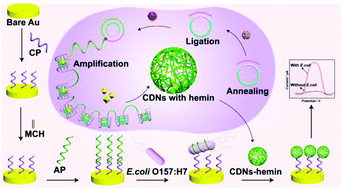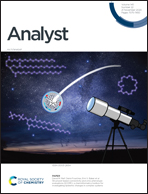An electrochemical aptasensor based on cocoon-like DNA nanostructure signal amplification for the detection of Escherichia coli O157:H7†
Abstract
We developed an electrochemical aptasensor based on cocoon-like DNA nanostructures as signal tags for highly sensitive and selective detection of Escherichia coli O157:H7. The stable cocoon-like DNA nanostructures synthesized by the rolling circle amplification reaction were loaded with hemin as electrochemical signal tags to amplify the signals. The single-stranded DNA capture probes were modified on the surface of a Au electrode via a Au–S bond. The E. coli O157:H7 specific aptamer and capture probe formed double-stranded DNA structures on the Au electrode. The aptamer preferentially bound to E. coli O157:H7, causing the dissociation of some aptamer-capture probes and releasing some capture probes. Subsequently, the free capture probes hybridized with the DNA nanostructures through the cDNA sequence. Under optimal conditions, the change in the electrochemical signal was proportional to the logarithm of E. coli O157:H7 concentration, from 10 to 106 CFU mL−1, and the detection limit was estimated to be 10 CFU mL−1. The electrochemical aptasensor could be readily used to detect various pathogenic bacteria and to provide a new method of early diagnosis of pathogenic microorganisms.



 Please wait while we load your content...
Please wait while we load your content...